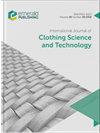基于结构参数的机织物有效导热系数建模及影响
IF 1
4区 工程技术
Q3 MATERIALS SCIENCE, TEXTILES
International Journal of Clothing Science and Technology
Pub Date : 2023-09-21
DOI:10.1108/ijcst-12-2021-0180
引用次数: 0
摘要
目的服装的传热性能对服装的热舒适性起着重要的作用。本文的目的是通过参数化数学模型,找出织物的传热性能与织物结构、纱线性能之间的关系,并预测单层机织物的有效导热系数。首先,将组织单元划分为四种类型的单元区域,包括纱线重叠区、纱线交叉区、纱线悬浮区和孔隙区。其次,分别计算各区域的数量和面积比例。建立了基于串联模型、并联模型或串并联混合模型的各单元区域有效导热系数计算公式。最后,根据编织单元中各区域的数量和面积比例,建立基于并行模型的织物厚度方向整体有效导热系数计算公式。结果进一步讨论了纱线间距、纱线宽度、织物厚度、空气层压缩系数和织物类型对有效导热系数的影响。在该模型中,有效导热系数与各参数之间的关系是一些不同阶次的多项式拟合曲线。编织类型主要通过不同元素的数量及其面积比影响有效导热系数的变化。在该模型中,分别建立了计算每个单元区域和整个编织单元有效导热系数的公式。考虑了纱线与周围空气的串并联混合特性,以及空气层的压缩系数。研究结果可进一步应用于不同经纱和纬纱密度或不同纱线热工性能的混纺织物的优化设计。本文章由计算机程序翻译,如有差异,请以英文原文为准。
Modeling and influence on effective thermal conductivity of woven fabrics based on structure parameters
Purpose The heat transfer properties play significant roles in the thermal comfort of the clothing products. The purpose of this paper is to find the relationship between heat transfer properties and fabrics' structure, yarn properties and predict the effective thermal conductivity of single layer woven fabrics by a parametric mathematical model. Design/methodology/approach First, the weave unit was divided into four types of element regions, including yarn overlap regions, yarn crossing regions, yarn floating regions and pore regions. Second, the number and area proportion of each region were calculated respectively. Some formulas were created to calculate the effective thermal conductivity of each element region based on serial model, parallel model or series–parallel mixing model. Finally, according to the number and area proportion of each region in weave unit, the formulas were established to calculate the fabric overall effective thermal conductivity in thickness direction based on the parallel models. Findings The influences of yarn spacing, yarn width, fabric thickness, the compressing coefficients of air layers and weave type on the effective thermal conductivity were further discussed respectively. In this model, the relationships between the effective thermal conductivity and each parameter are some polynomial fitting curves with different orders. Weave type affects the change of effective thermal conductivity mainly through the numbers of different elements and their area ratios. Originality/value In this model, the formulas were created respectively to calculate the effective thermal conductivity of each element region and whole weave unit. The serial–parallel mixing characteristics of yarn and surrounding air are considered, as well as the compression coefficients of air layers. The results of this study can be further applied to the optimal design of mixture fabrics with different warp and filling yarn densities or different yarn thermal properties.
求助全文
通过发布文献求助,成功后即可免费获取论文全文。
去求助
来源期刊
CiteScore
2.40
自引率
8.30%
发文量
51
审稿时长
10 months
期刊介绍:
Addresses all aspects of the science and technology of clothing-objective measurement techniques, control of fibre and fabric, CAD systems, product testing, sewing, weaving and knitting, inspection systems, drape and finishing, etc. Academic and industrial research findings are published after a stringent review has taken place.

 求助内容:
求助内容: 应助结果提醒方式:
应助结果提醒方式:


